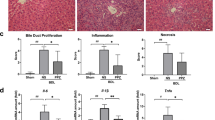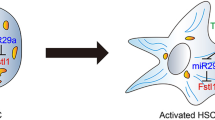Abstract
Acid-sensing ion channels (ASICs), a group of Na+-selective and Ca2+-permeant ligand-gated cation channels, can be transiently activated by extracellular acid. Among seven subunits of ASICs, acid-sensing ion channel 1a (ASIC1a), which is responsible for Ca2+ transportation, is elevated in response to inflammation, tumor, and ischemic injury in central nervous system and non-neuronal tissues. In this study, we demonstrated for the first time the presence of ASIC1a in rat liver and hepatic stellate cells (HSCs). Furthermore, the expression of ASIC1a was increased in primary HSCs and liver tissues of CCl4-treated rats, suggesting that ASIC1a may play certain role in liver fibrosis. Interestingly, we identified that the level of ASIC1a was significantly elevated in response to platelet-derived growth factor (PDGF) induction in a time- and dose-dependent manner. It was also established that Ca2+-transporting ASIC1a was involved in acid-induced injury of different cell types. Moreover, inhibition or silencing of ASIC1a was able to inhibit PDGF-induced pro-fibrogenic effects of activated rat HSCs, including cell activation, de novo synthesis of extracellular matrix components through mitogen-activated protein kinase signaling pathway. Collectively, our studies identified that ASIC1a was expressed in rat liver and HSCs and provided a strong evidence for the involvement of the ASIC1a in the progression of hepatic fibrosis.








Similar content being viewed by others
References
Waldmann R, Champigny G, Bassilana F, Heurteaux C, Lazdunski M (1997) A proton-gated cation channel involved in acid-sensing. Nature 386:173–177. doi:10.1038/386173a0
Chen CC, England S, Akopian AN, Wood JN (1998) A sensory neuron-specific, proton-gated ion channel. Proc Natl Acad Sci USA 95:10240–10245
Lingueglia E, de Weille JR, Bassilana F, Heurteaux C, Sakai H, Waldmann R, Lazdunski M (1997) A modulatory subunit of acid sensing ion channels in brain and dorsal root ganglion cells. J Biol Chem 272:29778–29783
Babinski K, Le KT, Seguela P (1999) Molecular cloning and regional distribution of a human proton receptor subunit with biphasic functional properties. J Neurochem 72:51–57
Xiong ZG, Chu XP, Simon RP (2006) Ca2+-permeable acid-sensing ion channels and ischemic brain injury. J Membr Biol 209:59–68. doi:10.1007/s00232-005-0840-x
Hu W, Chen FH, Yuan FL, Zhang TY, Wu FR, Rong C, Jiang S, Tang J, Zhang CC, Lin MY (2012) Blockade of acid-sensing ion channels protects articular chondrocytes from acid-induced apoptotic injury. Inflamm Res 61:327–335. doi:10.1007/s00011-011-0414-6
Rong C, Chen FH, Jiang S, Hu W, Wu FR, Chen TY, Yuan FL (2012) Inhibition of acid-sensing ion channels by amiloride protects rat articular chondrocytes from acid-induced apoptosis via a mitochondrial-mediated pathway. Cell Biol Int 36:635–641. doi:10.1042/CBI20110432
Yuan FL, Chen FH, Lu WG, Li X, Li JP, Li CW, Xu RS, Wu FR, Hu W, Zhang TY (2010) Inhibition of acid-sensing ion channels in articular chondrocytes by amiloride attenuates articular cartilage destruction in rats with adjuvant arthritis. Inflamm Res 59:939–947. doi:10.1007/s00011-010-0206-4
Geborek P, Saxne T, Pettersson H, Wollheim FA (1989) Synovial fluid acidosis correlates with radiological joint destruction in rheumatoid arthritis knee joints. J Rheumatol 16:468–472
Ouyang X, Ghani A, Mehal WZ (2013) Inflammasome biology in fibrogenesis. Biochim Biophys Acta 1832:979–988. doi:10.1016/j.bbadis.2013.03.020
Safadi R, Friedman SL (2002) Hepatic fibrosis–role of hepatic stellate cell activation. Med Gen Med 4:27
Uemura M, Swenson ES, Gaca MD, Giordano FJ, Reiss M, Wells RG (2005) Smad2 and Smad3 play different roles in rat hepatic stellate cell function and alpha-smooth muscle actin organization. Mol Biol Cell 16:4214–4224. doi:10.1091/mbc.E05-02-0149
Zhao Y, Wang Y, Wang Q, Liu Z, Liu Q, Deng X (2012) Hepatic stellate cells produce vascular endothelial growth factor via phospho-p44/42 mitogen-activated protein kinase/cyclooxygenase-2 pathway. Mol Cell Biochem 359:217–223. doi:10.1007/s11010-011-1016-x
Hashmi AZ, Hakim W, Kruglov EA, Watanabe A, Watkins W, Dranoff JA, Mehal WZ (2007) Adenosine inhibits cytosolic calcium signals and chemotaxis in hepatic stellate cells. Am J Physiol Gastrointest Liver Physiol 292:G395–G401. doi:10.1152/ajpgi.00208.2006
Kojima N, Hori M, Murata T, Morizane Y, Ozaki H (2007) Different profiles of Ca2+ responses to endothelin-1 and PDGF in liver myofibroblasts during the process of cell differentiation. Br J Pharmacol 151:816–827. doi:10.1038/sj.bjp.0707269
Bian EB, Huang C, Ma TT, Tao H, Zhang H, Cheng C, Lv XW, Li J (2012) DNMT1-mediated PTEN hypermethylation confers hepatic stellate cell activation and liver fibrogenesis in rats. Toxicol Appl Pharmacol 264:13–22. doi:10.1016/j.taap.2012.06.022
Seglen PO (1976) Preparation of isolated rat liver cells. Methods Cell Biol 13:29–83
Yermolaieva O, Leonard AS, Schnizler MK, Abboud FM, Welsh MJ (2004) Extracellular acidosis increases neuronal cell calcium by activating acid-sensing ion channel 1a. Proc Natl Acad Sci USA 101:6752–6757. doi:10.1073/pnas.0308636100
Pandey AK, Hazari PP, Patnaik R, Mishra AK (2011) The role of ASIC1a in neuroprotection elicited by quercetin in focal cerebral ischemia. Brain Res 1383:289–299. doi:10.1016/j.brainres.2011.01.085
Dong P, Yu F, Fan X, Lin Z, Chen Y, Li J (2010) Inhibition of ATIR by shRNA prevents collagen synthesis in hepatic stellate cells. Mol Cell Biochem 344:195–202. doi:10.1007/s11010-010-0542-2
Leask A, Abraham DJ (2004) TGF-beta signaling and the fibrotic response. FASEB J 18:816–827. doi:10.1096/fj.03-1273rev
Amaya MJ, Nathanson MH (2013) Calcium signaling in the liver. Compr Physiol 3:515–539. doi:10.1002/cphy.c120013
Roth-Eichhorn S, Eberheim A, Bode HP, Gressner AM (1999) Transformation-dependent calcium influx by voltage-operated calcium channels in stellate cells of rat liver. J Hepatol 30:612–620
Kim SY, Cho BH, Kim UH (2010) CD38-mediated Ca2+ signaling contributes to angiotensin II-induced activation of hepatic stellate cells: attenuation of hepatic fibrosis by CD38 ablation. J Biol Chem 285:576–582. doi:10.1074/jbc.M109.076216
Watanabe A, Hashmi A, Gomes DA, Town T, Badou A, Flavell RA, Mehal WZ (2007) Apoptotic hepatocyte DNA inhibits hepatic stellate cell chemotaxis via toll-like receptor 9. Hepatology 46:1509–1518. doi:10.1002/hep.21867
Wang Y, Cheng M, Zhang B, Nie F, Jiang H (2013) Dietary supplementation of blueberry juice enhances hepatic expression of metallothionein and attenuates liver fibrosis in rats. PLoS ONE 8:e58659. doi:10.1371/journal.pone.0058659
Friedman SL (2000) Molecular regulation of hepatic fibrosis, an integrated cellular response to tissue injury. J Biol Chem 275:2247–2250
Ding Z, Zhuo L (2013) Attenuation of hepatic fibrosis by an imidazolium salt in thioacetamide-induced mouse model. J Gastroenterol Hepatol 28:188–201. doi:10.1111/j.1440-1746.2012.07265.x
Magness ST, Bataller R, Yang L, Brenner DA (2004) A dual reporter gene transgenic mouse demonstrates heterogeneity in hepatic fibrogenic cell populations. Hepatology 40:1151–1159. doi:10.1002/hep.20427
Atorrasagasti C, Aquino JB, Hofman L, Alaniz L, Malvicini M, Garcia M, Benedetti L, Friedman SL, Podhajcer O, Mazzolini G (2011) SPARC downregulation attenuates the profibrogenic response of hepatic stellate cells induced by TGF-beta1 and PDGF. Am J Physiol Gastrointest Liver Physiol 300:G739–G748. doi:10.1152/ajpgi.00316.2010
Matsuzawa A, Ichijo H (2005) Stress-responsive protein kinases in redox-regulated apoptosis signaling. Antioxid Redox Signal 7:472–481. doi:10.1089/ars.2005.7.472
Acknowledgments
This project was supported by the China National Science Foundation Grants (No. 81100301, 81271949).
Conflict of Interest
The authors declare no conflict of interest.
Author information
Authors and Affiliations
Corresponding author
Additional information
Fan-rong Wu and Chun-xiao Pan contributed equally to this work.
Rights and permissions
About this article
Cite this article
Wu, Fr., Pan, Cx., Rong, C. et al. Inhibition of acid-sensing ion channel 1a in hepatic stellate cells attenuates PDGF-induced activation of HSCs through MAPK pathway. Mol Cell Biochem 395, 199–209 (2014). https://doi.org/10.1007/s11010-014-2125-0
Received:
Accepted:
Published:
Issue Date:
DOI: https://doi.org/10.1007/s11010-014-2125-0




